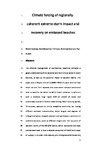Climate forcing of regionally-coherent extreme storm impact and recovery on embayed beaches
| dc.contributor.author | Burvingt, Olivier | |
| dc.contributor.author | Masselink, Gerd | |
| dc.contributor.author | Scott, Tim | |
| dc.contributor.author | Davidson, Mark | |
| dc.contributor.author | Russell, Paul | |
| dc.date.accessioned | 2018-05-10T07:57:45Z | |
| dc.date.issued | 2018-07-01 | |
| dc.identifier.issn | 0025-3227 | |
| dc.identifier.issn | 1872-6151 | |
| dc.identifier.uri | http://hdl.handle.net/10026.1/11476 | |
| dc.description.abstract |
© 2018 The effective management of sedimentary coastlines demands a good understanding of the seasonal and inter-annual cycles in beach volumes, as well as the potential impact of extreme events. This paper uses a 10-year time series (2007–2017) of supra- and intertidal beach volume from exposed and cross-shore transport-dominated sites to examine the extent to which beach behaviour is coherent over a relatively large region (100-km stretch of coast) and predictably coupled to incident wave forcing. Over the study period, 10 beaches, exposed to similar wave/tide conditions, but having different sediment characteristics, beach lengths and degrees of embaymentisation, showed coherent and synchronous variations in sediment volumes, albeit at different magnitudes. The sequence of extreme storms of the 2013/14 winter, which represents the most erosive event over at least a decade along most of the Atlantic coast of Europe, is included in the data set, and three years after this winter, beach recovery is still on-going for some of the 10 beaches. Post-storm beach recovery was shown to be mainly controlled by post-storm winter wave conditions, while summer conditions consistently contributed to modest beach recovery. Skilful hindcasts of regional changes in beach volume were obtained using an equilibrium-type shoreline model (ShoreFor; Davidson et al., 2013), demonstrating that beach changes are coherently linked to changes in the offshore wave climate and are sensitive to the antecedent conditions. The ShoreFor model can successfully be applied to exposed coastal areas dominated by cross-shore sediment transport, and can also be used as a relatively simple and regional tool for the future management of beaches where coherence in coastal response is observed. Furthermore, a good correlation was found between the beach volume changes and the new climate index WEPA (West Europe Pressure Anomaly; Castelle et al., 2017b), which offers new perspectives for the role and the use of climatic variations proxies to forecast coastline evolution. | |
| dc.format.extent | 112-128 | |
| dc.language | en | |
| dc.language.iso | en | |
| dc.publisher | Elsevier BV | |
| dc.rights | Attribution-NonCommercial 4.0 International | |
| dc.rights | Attribution-NonCommercial 4.0 International | |
| dc.rights | Attribution-NonCommercial 4.0 International | |
| dc.rights | Attribution-NonCommercial 4.0 International | |
| dc.rights.uri | http://creativecommons.org/licenses/by-nc/4.0/ | |
| dc.rights.uri | http://creativecommons.org/licenses/by-nc/4.0/ | |
| dc.rights.uri | http://creativecommons.org/licenses/by-nc/4.0/ | |
| dc.rights.uri | http://creativecommons.org/licenses/by-nc/4.0/ | |
| dc.subject | 13 Climate Action | |
| dc.title | Climate forcing of regionally-coherent extreme storm impact and recovery on embayed beaches | |
| dc.type | journal-article | |
| dc.type | Article | |
| plymouth.author-url | https://www.webofscience.com/api/gateway?GWVersion=2&SrcApp=PARTNER_APP&SrcAuth=LinksAMR&KeyUT=WOS:000435056400008&DestLinkType=FullRecord&DestApp=ALL_WOS&UsrCustomerID=11bb513d99f797142bcfeffcc58ea008 | |
| plymouth.volume | 401 | |
| plymouth.publication-status | Published | |
| plymouth.journal | Marine Geology | |
| dc.identifier.doi | 10.1016/j.margeo.2018.04.004 | |
| plymouth.organisational-group | /Plymouth | |
| plymouth.organisational-group | /Plymouth/Admin Group - REF | |
| plymouth.organisational-group | /Plymouth/Admin Group - REF/REF Admin Group - FoSE | |
| plymouth.organisational-group | /Plymouth/Faculty of Science and Engineering | |
| plymouth.organisational-group | /Plymouth/Faculty of Science and Engineering/School of Biological and Marine Sciences | |
| plymouth.organisational-group | /Plymouth/REF 2021 Researchers by UoA | |
| plymouth.organisational-group | /Plymouth/REF 2021 Researchers by UoA/UoA07 Earth Systems and Environmental Sciences | |
| plymouth.organisational-group | /Plymouth/Research Groups | |
| plymouth.organisational-group | /Plymouth/Research Groups/Marine Institute | |
| plymouth.organisational-group | /Plymouth/Users by role | |
| plymouth.organisational-group | /Plymouth/Users by role/Academics | |
| plymouth.organisational-group | /Plymouth/Users by role/Researchers in ResearchFish submission | |
| dcterms.dateAccepted | 2018-04-10 | |
| dc.rights.embargodate | 2019-4-21 | |
| dc.identifier.eissn | 1872-6151 | |
| dc.rights.embargoperiod | 12 months | |
| rioxxterms.versionofrecord | 10.1016/j.margeo.2018.04.004 | |
| rioxxterms.licenseref.uri | http://creativecommons.org/licenses/by-nc/4.0/ | |
| rioxxterms.licenseref.startdate | 2018-07-01 | |
| rioxxterms.type | Journal Article/Review | |
| plymouth.funder | Physical and biological dynamic coastal processes and their role in coastal recovery (BLUE-coast)::NERC | |
| plymouth.funder | Physical and biological dynamic coastal processes and their role in coastal recovery (BLUE-coast)::NERC |



